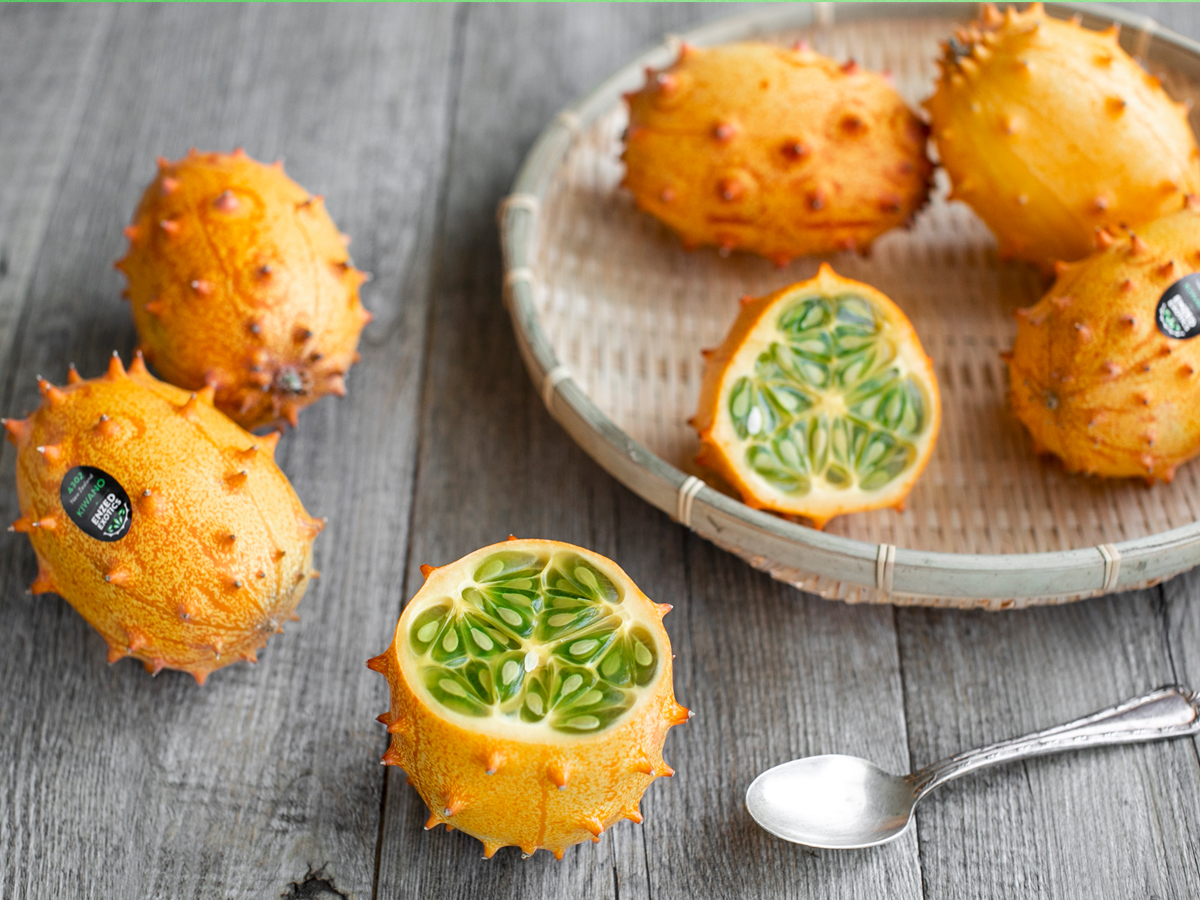
“What is this thing – and er, what do I do with it?” Those tentative words are like music to a Kiwano lovers’ ear. Why? It means someone is about to discover the super healthy exotic fruit that we’re a little bit (ok, a lot : ) in love with.
What is a Kiwano?
Kiwano (sometimes known as a horned melon or kiwano melon) is an exotic fruit, native to Sub-Saharan Africa. Seedlings are planted in spring and the fruit becomes perfectly ripe during the hot summer season (January-April here in New Zealand).
The fruit grow on low bushy vines which run along the ground. It starts off small and very spiky and grows larger (the size of a large avocado is a good comparison for mature fruit) before turning a deep golden orange when ripe.

Inside the Kiwano’s golden skin is a vibrant green jelly-like pulp, which can be eaten fresh or used in drinks, savoury dishes and desserts. The taste is most often described as a refreshingly fruity mix of banana, passionfruit and lime.

How do you know when Kiwano is ripe?
A Kiwano is ready to eat when the skin is a bright golden orange. Look for Kiwano that are shiny, plump and deeply golden in colour.
How to prepare:
Due to its spiky horns, Kiwano might look little scary but are actually very easy to prepare and eat.
Hold gently on a board or bench avoiding the small horns (these are perfectly safe, just a little spiky) and use a knife to slice down the middle or lengthways. There are 3 main ways to remove the pulp:
- The Scoop: Push a knife into the pulp several times to loosen it away from the skin. Then take a spoon and scoop out the pulp into a bowl (or your mouth.
- The Squeeze: This is the fastest way to remove the pulp. As above, push a knife into the half Kiwano in several different places just to loosen the pulp. Using both hands, hold it gently between the spikes and squeeze the pulp into a bowl or glass.
- The Muddle: This is best done with a Kiwano cut in half lengthways. Take a spoon and push it repeatedly into the pulp, so that the pulp all comes away from the edge of the skin. Using this method the skin becomes a bowl for the delicious pulp.

How to serve Kiwano:
Kiwano is an incredibly versatile fruit. It’s cool pulp is great in savoury dishes such as raita, guacamole, salsas & salads as well as in desserts, juices, cocktails, mocktails, smoothies, or scooped over yogurt or granola. Fresh Kiwano is also delicious sprinkled with a little hot sauce and sea salt. Another way to enjoy is to use the pulp as a healthy, refreshing topping for seafood, sashimi, tacos or grilled chicken. Or just eat it fresh as a healthy fruit snack.

Can you eat the seeds?
Yes definitely! The seeds are very slim and encased inside the green jelly-like pulp – so there’s no “crunch” when you eat them.

Can you eat Kiwano skin?
Yes the skin is edible – this is really a personal preference as it doesn’t have the flavour of the pulp. If you do want to eat the entire skin, just be sure to slice of the small horns first.
Kiwano Nutrition & Health Benefits
Kiwano are great for your health. Hydrating and filling, they are also a source of magnesium, potassium and dietary fibre.
- Magnesium is an important mineral to keep our body in optimum working order. It aids better sleep by reducing muscle tension, helps to reduce tiredness, and maintain strong bones and a healthy metabolism.
- Potassium is necessary for keeping a normal water balance in our body, supports healthy muscle function, and contributes to children’s normal growth and development.
- Dietary fibre helps to keep our bowel movements regular, and well as helping us feel fuller for longer.
- Low in naturals sugars and kJ, Kiwano are a great choice for people who love the taste and nutrition of fruit, but are watching their energy intake.
How to store:
One final thing. Kiwano don’t like the cold and should be stored at room temperature or above 18 degrees Celsius (64F). So, keep out of the fridge! You can keep any leftover pulp in the pulp for a day or two at the most (it starts to go a bit watery after this.) As with many fruits and foods, the fruit’s flavour is at its best when eaten at room temperature.
We hope that covers off your burning questions about our favourite fruit! But as ever, if you have any questions just drop us a email or comment below.




Ron Horner says:
Thankyou for the information. A Kiwano vine has grown in our backyard amongst our passionfruit vine, it seems quite happy. We will now wait until its skin turns orange and sample the wares.
Moana Simm says:
All the best with your Kiwano growing Ron! Please have a look at our recipes page for ideas on how to eat your crop : )
Brigitte says:
Just a question: Our Kiwano fruits taste a little bitter. Are they still edible? We are on a farm in Zambezi region in Namibia. Kiwano fruits are growing wild here but not too many.
Moana Simm says:
Hi Brigette,
Are they mostly orange all over? Your Kiwano is ripe when it is golden orange colour all over – a few green patches are ok but should be mostly orange.
Thanks!